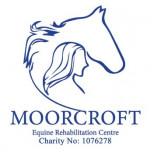Posted: 1st July 2025 | Back to news feed

Charity treats almost 50% more horses in May as owners become more pro-active and confident in equine care
A pleasing shift is underway in the equestrian world as an increasing number of horse owners demonstrate strong awareness of the expanding opportunities to prolong the sound, healthy lives of their equine companions, according to Mary Frances, Chief Executive of Moorcroft Equine Rehabilitation Centre in West Sussex. Mary believes a growing emphasis on preventative care and advanced treatment options reflects a deeper understanding among horse owners of equine welfare and the potential to maximise their horses' athletic careers and overall wellbeing.

Mary, who has headed up the charity for the past 20 years, believes a fundamental change is afoot. “Owners are increasingly recognising that innovative veterinary treatments and rehabilitation techniques are no longer solely reserved for acute injuries, but can play a crucial role in maintaining soundness, managing chronic conditions, and extending the active lives of their horses.
"The landscape of equine healthcare has evolved dramatically, and organisations such as Moorcroft have responded to this. First and foremost, we offer horse owners an expert ear when they feel their horse is not right, before using evidence-based diagnostic systems to find out where the discomfort starts. Guesswork is simply not good enough and can often waste both time and money.
“We have the right education and experience of the equine anatomy to understand what happens when horses are allowed to move with incorrect posture. Through this, we’ve been able to help so many horses – and their owners - which have been brought to Moorcroft recently.
“Long-term preventative measures are key to good welfare and happy, sound horses, and can make a huge difference in a horse's longevity and quality of life. From regenerative therapies to targeted rehabilitation protocols, we’re seeing fantastic progress that empowers owners to be more proactive in the care of their horses."
This positive trend is underscored by anecdotal evidence from Moorcroft Equine Rehabilitation Centre, based in Slinfold. The charity reported its busiest month on record in May, treating an unprecedented 25 horses – an increase of 47% compared to a typical month in 2024. According to Mary, this surge in activity highlights the growing demand from horse owners to be heard, and their willingness to seek help when they feel their horse is not comfortable. “They’re willing to invest in the diagnostic and treatment offering at Moorcroft to both prevent and resolve these issues long term”, she adds.
Key advancements and approaches contributing to this extended soundness include:
- Regenerative Therapies: Treatments such as platelet-rich plasma (PRP) are increasingly used to promote healing and repair damaged tissues, offering new hope for injuries that were once career-ending.
- Long reining: This increasingly important method is key to enabling a better understanding of how to strengthen the equine anatomy and in preventing initial injury or further injury.
- Muscle development: Measurement of muscle development through the spine rather than relying on guesswork. Tailored exercise programmes are also crucial for particular weaknesses and lameness.
- A deeper understanding of the treatment of stomach ulcers: Finding the source of pain and relieving it first, holistically. Otherwise, pain and stress will result.
- Preventative foot care: Understanding that the angle of your horse’s pastern-to-foot is vital to soundness and must be taken care of with good farriery and trimming.
- Specialised Farriery: Advancements in corrective and therapeutic farriery play a vital role in addressing conformational issues and supporting injured limbs, contributing significantly to soundness. ‘Barefoot’ is good too for many horses, if they are comfortable. The angle of pastern to hoof is important and the health of the hoof is essential to soundness, so a good podiatrist is essential.
Despite these significant advancements, there remains a crucial need for continued education and awareness within the equestrian community. While reactive treatments are vital, the industry must further embrace the adage that ‘prevention is better than cure’, and early diagnosis and treatment are essential for optimal outcomes.
Mary is encouraging horse owners to:
- Listen to your horse. They are very stoic so if they are struggling regularly in any of the three paces, they will be telling you that something is not quite right. Prioritise regular physiotherapy to ensure your work is not creating pain and understand your horses age and ability and work accordingly. Not pushing your horse out of his or her comfort zone is vital to soundness and muscle building etc.
- Learn to recognise subtle signs of lameness or discomfort, such as a shortness in stride or a reluctance to be tacked up, not taking a particular lead in canter, going disunited and seek an early diagnosis.
- Invest in ongoing education to build your own confidence and increase your skills. Try to work closely with evidence-based systems as guesswork is expensive and time consuming.
Mary adds: “The commitment of horse owners to leverage these advancements, coupled with a stronger emphasis on preventative strategies and early intervention, signals a promising future for equine welfare. The goal is not just to treat illness but to actively promote and maintain the sound, healthy lives of horses for as long as possible.”
Moorcroft will be running a dedicated long-reining course on Saturday 19th July, to help improve a horse’s posture and strength. The course will incorporate work on straight lines in a good outline, strengthening and lifting the horse’s back so they become comfortable and happy for riders to sit on. For more information or to book a place, please visit moorcroftracehorse.org.uk/events.
The Equestrian Index newsfeed is compiled from articles submitted by advertising members and expresses the opinions of those members. Watsons Directories Ltd shall not be held liable for any inaccuracies or mis-statements therein.